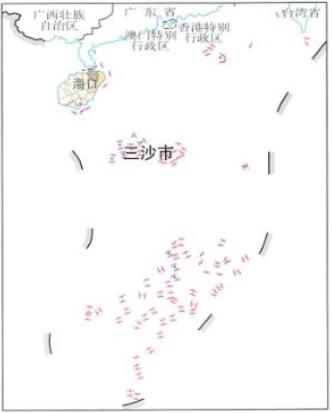Online map of disaster frequency distribution by disaster type in Hainan Province in 2014
Category: China Nature Disaster
Map description
Map source
The online map of disaster frequency distribution by disaster type in Hainan Province in 2014 is from the Atlas of natural disasters in China in 2014, the book is edited by the National Disaster Reduction Commission Office, the Disaster relief Department of the Ministry of Civil Affairs, the National Disaster Reduction Center of Ministry of Civil Affairs, and is published by China Map Publishing House. The scale of this map is 1:22000000.
Hainan Province

In 2014, the disaster situation in Hainan Province was more serious than that in recent years, mainly typhoon disaster, the area of crop failure and the number of damaged houses were the highest in recent years.
1.Less number of tropical cyclones
From July to September, there are four tropical cyclones affecting Hainan, two of which are tropical low pressure, and the total number is 1-3 less than that of the normal year, the first tropical cyclone that affected Hainan occurred in the first ten days of July, 10 days later than that of the year.
2.Less frequency of disasters and great influence of typhoon
A total of 3 natural disasters were affected throughout the year, including 2 typhoons "Ramason" and "Seagull" and 1 flood, both typhoons made landfall in Wengtian Town, Wenchang City. The wind speeds at the landing centers were level 17 and 14 respectively with high intensity, similar landing points and paths, this resulted in repeated disasters in some areas and heavy losses in the disaster areas. It is the strongest typhoon that has affected Hainan in 41 years, affected by the two typhoons, heavy rain fell across the province, local tornadoes occurred, and seawater intrusion occurred in some areas, resulting in the failure of farmland to be cultivated and a decline in food production.
The proportion of the total number of disasters in the region (%):
The closer to the dark yellow area, the higher the proportion of the total number of disasters in the area.
The closer to the light yellow area, the lower the proportion of the total number of disasters in the area.
The white area in the figure shows: Non affected areas.
The orange sector in the figure shows: Drought disaster.
The blue sector in the figure shows: Floods and geological disasters.
The brown sector in the figure shows: Wind and hail disaster.
The green sector in the figure shows: Typhoon disaster.
The pink sector in the figure shows: Earthquake disaster.
The purple sector in the figure shows: Low temperature freezing and snow disaster.
- Historical map of the Southern Song Dynasty and the Jin Dynasty in 1208 AD
- The Historical Maps of Qi State, Lu State and Song State During the Warring States Period in China
- Historical Maps of Chu State, Wu State and Yue State in Spring and Autumn Period of China
- A Historical Map of the Early Site of Chinese Primitive Society (Paleolithic Age)
- Online map of non-metallic mineral resources in Wenchuan disaster area in China